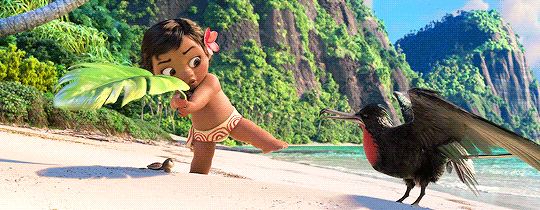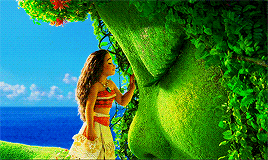Moana is an absolute revelation to me, and I weep whenever I watch it. This is, I think, because above all else, Moana is a story about women. Though a male demigod features prominently in the movie, at its heart, Moana is about the coming of age of a young woman, about her relationships with the matriarchs who came before her, and about the feminine forms of heroism that she is uniquely capable of performing.
The first heroic act we see Moana perform (the first act we see her perform, in fact) is helping a sea turtle on the beach get to the water safely. Moana sees a beautiful shell right at the shoreline, but looks back and sees the turtl hiding from the sun and some hungry birds under the fronds of a plant. Moana is able to assess the situation, see another creature in distress, and understand what that creature needs. And then she does it! This is why the ocean chooses her – because she’s uniquely adept at emotional work, at seeing other creatures in distress and helping them do what they need to do to be in a better situation.

Moana, we are told, is going to be the chief one day. And it seems perfectly fine and not a point of contention that Moana will be a female leader. But we know, because Moana’s father says so, that most of the previous chiefs have been men. Moana’s father takes her up to the top of the island and shows her a stack of stones, telling her that when she becomes chief, she will add a stone, as he and his father did before. So although Moana is certainly allowed to hold power, we explicitly know that she’s breaking a patriarchal tradition, and that power in this culture has (in recent memory) been held by men.
The village also seems to have a strong matriarchal system as well. In fact, most of the major plot points in the movie are accomplished by women: Moana’s mother performs the emotional labor of revealing Moana’s father’s backstory when he is not able to, and Moana’s grandmother tells Moana the stories of their people and encourages Moana to grow into the person she wants to be and not just the person she’s told to be. At the pivotal moment, Moana’s grandmother is the one to encourage Moana to go out on her hero’s journey, and to continue on that journey when all hope seems lost. The women in this story perform a lot of emotional labor – they are great at assessing emotional needs and then helping to fulfill those emotional needs. Moana learns how to do that kind of emotional labor from the women in her life. Not to mention, the whole world and the people in it were created by a benevolent nature goddess. Women are wielding a lot of authority.

Moana’s hero quest revolves around this nature goddess. At the very beginning of the story, we learn the story of Maui, a trickster demigod god who commits a violent act on Te Fiti, the creation goddess. Because of this act of violence, the ocean and islands are dying. Moana embarks on her hero’s journey, believing that she’s going to go find Maui and help him restore Te Fiti’s heart. In order to do this, Maui must defeat Te Ka, a fire demon who awoke when Te Fiti’s heart was stolen. Maui, a swashbuckling hero with a giant fish hook, seems like the one with the best shot at defeating Te Ka. However, when they arrive and Maui gets his chance, he’s not able to defeat, or even get past Te Ka. Having failed at his hero quest, Maui abandons the mission and the ship. This is fine, because as it turns out, Moana is the actual hero of the story. (This movie isn’t called Maui; it’s your movie, Moana!)
Moana must go back and complete the hero’s quest herself. And it turns out, Moana is the Chosen One for a damn good reason. A masculine model of heroism is fundamentally incapable of fixing this situation. A feminine model of heroism is required, the same model of heroism Moana has been embodying from the get go. As it turns out, Te Ka is not the enemy. Te Ka is Te Fiti, not a monstrous woman at all, but a woman who’s undergone profound trauma (this is the case for most supposedly monstrous women, I would argue). Maui is not able to see this, but Moana sees it quickly. Moana is able to see someone else in pain, to see past trauma, to treat Te Ka gently, to remind Te Ka of who she is, and to restore her heart.

This kind of work, this heroism grounded in empathy and emotional labor, is profoundly feminine, and it makes me deeply emotional. This is not merely a movie in which girls can fight, too. This is a movie in which historically undervalued skills and labor are made heroic, which reveals the inadequacies of a tradiotional masculine, sword-wielding brand of heroism. It’s not just that women can also save the world. In this story, they are the only ones who can.
Images: Moana/Disney
More from BUST
Disney’s “Moana” And Climate Change
“Moana” Is Making Waves As Disney’s Newest Heroine Of Color
Lin-Manuel Miranda Is Teaming Up With Disney In This Incredible Way


